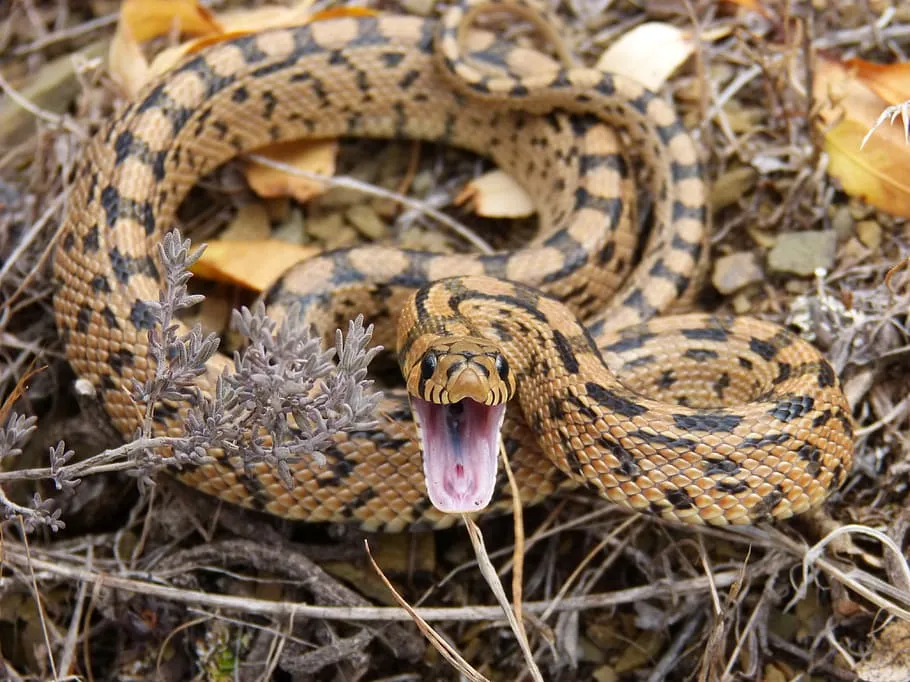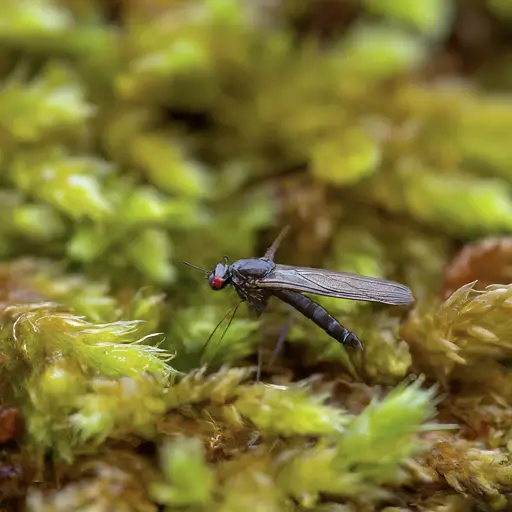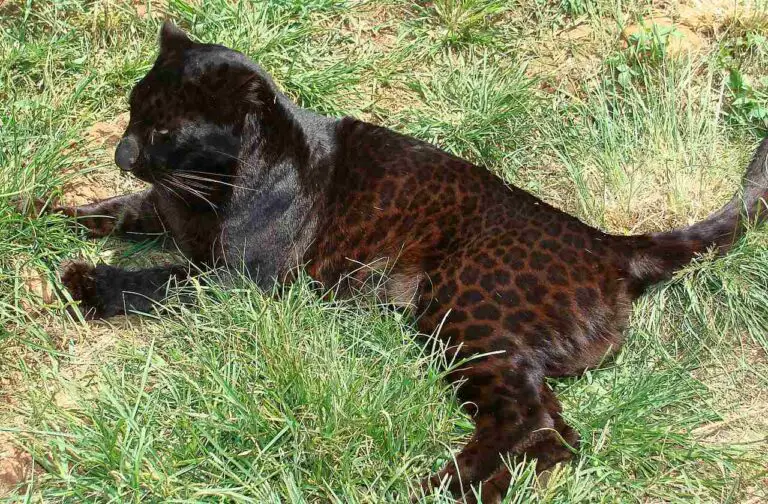25+ Dangerous Animals In Michigan And Their Characteristics
Examples of dangerous animals in Michigan are the Black Bear, Gray Wolf, Eastern Massasauga Rattlesnake, and Brown Recluse Spider. These animals, while often avoiding human contact, can become dangerous if threatened or startled. The Black Bear, for instance, can be aggressive when protecting its young, while the Gray Wolf can defend its territory if it feels encroached upon. The Eastern Massasauga Rattlesnake is Michigan’s only venomous snake, capable of inflicting a harmful bite, and the Brown Recluse Spider’s venom can cause severe skin damage. To ensure safety, it is essential to be aware of their presence and exercise caution in areas where these animals are found.
1. Black Bear
The Black Bear is the most commonly found bear in Michigan’s forests, with a population spread across the northern regions and the Upper Peninsula. Generally, these bears are shy and prefer to avoid human contact, but they can become dangerous if they feel threatened, are startled, or are protecting their young. In certain cases, Black Bears are attracted to human settlements by the scent of food or garbage, leading to potential encounters. Though attacks on humans are rare, it’s crucial to remain cautious in bear territory, making noise to alert them of your presence and storing food securely to prevent unwanted visits. If you encounter a Black Bear, avoid eye contact, back away slowly, and never run, as this could trigger a chase response. Being informed about their behavior and knowing how to respond to a bear sighting is essential for safety in areas where these animals roam.
2. Gray Wolf
The Gray Wolf, native to Michigan’s Upper Peninsula, is a social predator known for its pack structure and hunting prowess. These wolves generally avoid human interaction, sticking to dense forests and remote wilderness areas. While they pose little direct threat to humans, conflicts can arise if they are threatened or if their prey sources, such as deer, are compromised. Gray Wolves play a crucial role in the ecosystem by controlling prey populations, but their recovery in Michigan has sparked debates on how to manage their presence near human settlements. It’s essential to maintain distance and respect the wolves’ territory, and if you encounter them in the wild, avoid running or acting aggressively, as this could provoke a defensive response.
3. Eastern Massasauga Rattlesnake
The Eastern Massasauga Rattlesnake is Michigan’s only venomous snake, typically found in wetlands and low-lying areas. This reclusive reptile prefers to avoid humans, but its bite can be dangerous if provoked or stepped on by accident. It’s a small-to-medium-sized rattlesnake with a rattle that serves as a warning signal. If you encounter one, it’s best to back away slowly and allow the snake to escape. The Eastern Massasauga is a protected species, making it illegal to harm or kill it, highlighting the importance of coexisting with these unique reptiles. To reduce the risk of encounters, be cautious while hiking through marshy or brushy terrain, and wear protective footwear.
4. Brown Recluse Spider
The Brown Recluse Spider, a venomous arachnid occasionally found in southern Michigan, is known for its necrotic venom that can cause severe skin damage. These spiders are small and typically reside in hidden places like woodpiles, under furniture, or in attics. While bites are rare, they can occur when the spider is accidentally disturbed. Symptoms of a Brown Recluse bite can range from mild irritation to significant tissue damage, requiring medical attention. To reduce the risk of bites, avoid reaching into dark or hidden spaces without protective gloves, and maintain a clean living environment. If bitten, seek medical help promptly to prevent complications.
5. Timber Rattlesnake
The Timber Rattlesnake, once common in Michigan’s forests, is now found mainly in the southern regions and is a state-protected species. This large rattlesnake prefers wooded areas and is known for its distinctive rattling sound when threatened. Although generally non-aggressive, Timber Rattlesnakes can become defensive if cornered or surprised. Their venom is potent and can cause severe harm, making caution crucial in their habitats. When exploring wooded trails or remote areas, keep an eye on the ground, wear sturdy footwear, and avoid disturbing rocks or logs where these snakes might be hiding. If you hear the characteristic rattle, back away slowly and give the snake ample space.
6. Cougar (Mountain Lion)
The Cougar, also known as the Mountain Lion, is a large and elusive predator occasionally sighted in Michigan. Although rare, these powerful cats can be dangerous, especially if they feel threatened or are stalking prey. Cougars typically avoid human contact, preferring dense forests and remote areas. If you encounter a Cougar, it’s crucial to remain calm, make yourself appear larger, and back away slowly without turning your back on the animal. Never run, as this could trigger a predatory response. To minimize the risk of encounters, avoid hiking alone in remote areas, keep pets close, and make noise to alert Cougars to your presence.
7. Coyote

The Coyote is a highly adaptable predator found throughout Michigan, often thriving in both rural and urban environments. While generally wary of humans, Coyotes can pose a threat to pets and small livestock, and in rare cases, may become aggressive toward people, especially if they are protecting their territory or young. Coyotes are opportunistic feeders and may be attracted to food sources like garbage, pet food, or compost. To reduce conflicts, keep food sources secure, supervise pets when outdoors, and avoid feeding or approaching Coyotes. If you encounter a Coyote, make loud noises, stand tall, and wave your arms to scare it away.
8. American Black Widow Spider
The American Black Widow Spider is a venomous arachnid occasionally found in Michigan, recognizable by its shiny black body and red hourglass-shaped marking on the abdomen. These spiders prefer dark, sheltered areas like woodpiles, sheds, or basements, where they build irregular webs. Although Black Widow bites are rare, their venom can cause severe pain, muscle cramps, and other serious symptoms, requiring prompt medical attention. To prevent bites, exercise caution when reaching into dark or hidden spaces, and wear gloves when handling firewood or debris. If bitten, seek medical care immediately and try to identify the spider if possible to aid in treatment.
9. Bobcat
The Bobcat is a medium-sized wild cat native to Michigan, typically found in forested and brushy areas. These elusive animals are known for their tufted ears and short “bobbed” tail. While Bobcats generally avoid humans, they can become aggressive if threatened or if their habitat is encroached upon. They primarily hunt small mammals like rabbits and rodents, but in rare cases, they may prey on small pets or livestock. To avoid conflicts with Bobcats, keep pets indoors at night, secure garbage, and avoid leaving food outside. If you encounter a Bobcat, do not approach it; instead, back away slowly and give it space to retreat.
10. Fisher
The Fisher is a medium-sized carnivorous mammal found in Michigan’s dense forests. It belongs to the weasel family and is known for its agility and ferocity. Fishers are generally shy and avoid human contact, but they can pose a threat to small pets and livestock. They are skilled climbers and often hunt small mammals like rabbits, squirrels, and porcupines. Although attacks on humans are extremely rare, Fishers can become aggressive if threatened or cornered. To prevent encounters, keep small pets indoors at night, secure food sources, and avoid leaving compost or garbage accessible. If you come across a Fisher, keep your distance and do not provoke it.
11. Bald-Faced Hornet
The Bald-Faced Hornet is a large, aggressive wasp found throughout Michigan. Despite its name, it is not a true hornet but rather a type of yellowjacket. These hornets build large, papery nests in trees or shrubs, and they are highly protective of their territory. A Bald-Faced Hornet sting can be extremely painful and, in some cases, cause severe allergic reactions. To avoid stings, stay away from their nests and do not attempt to remove them yourself; instead, call a professional exterminator. If stung, monitor for signs of allergic reactions and seek medical attention if symptoms like swelling or difficulty breathing occur.
12. Northern Black Racer
The Northern Black Racer is a non-venomous snake commonly found in Michigan’s forests and open fields. Known for its sleek black scales and swift movements, this snake is harmless to humans but can be startling due to its size and speed. Black Racers are active during the day and typically hunt small mammals and birds. Although they are not dangerous, they may act defensively if cornered or threatened, emitting a musky odor and shaking their tail to mimic a rattlesnake’s warning. If you encounter a Black Racer, it’s best to keep your distance and allow it to slither away on its own.
13. Red-Tailed Hawk
The Red-Tailed Hawk is one of Michigan’s most common birds of prey, easily recognized by its broad wings and reddish-brown tail. These raptors are generally not dangerous to humans but can be aggressive if they feel threatened or are protecting their nests. Red-Tailed Hawks primarily hunt small mammals, birds, and reptiles, and are known for their keen eyesight and powerful talons. To avoid conflicts, it’s best to observe these birds from a distance and refrain from disturbing their nests or perching areas. If a Red-Tailed Hawk exhibits aggressive behavior, such as diving toward people or pets, move away and give it space.
14. Eastern Cottontail Rabbit
The Eastern Cottontail Rabbit is a common sight in Michigan’s fields and woodlands, recognized by its fluffy white tail. Although these rabbits are generally harmless, they can carry tularemia, a bacterial infection that can be transmitted to humans and pets through bites, scratches, or contact with contaminated carcasses. Tularemia symptoms include fever, chills, and swollen lymph nodes, requiring prompt medical treatment. To minimize the risk of infection, avoid handling wild rabbits and ensure pets are vaccinated. If you must handle a rabbit, wear protective gloves and wash your hands thoroughly afterward.
15. Eastern Hog-Nosed Snake
The Eastern Hog-Nosed Snake is a unique non-venomous snake found in Michigan, known for its upturned snout and defensive behaviors. When threatened, this snake may puff up its body, hiss loudly, and even play dead to deter predators. Although these behaviors can be startling, the Eastern Hog-Nosed Snake is harmless to humans. It primarily feeds on toads and other small prey, preferring sandy or wooded habitats. If you encounter an Eastern Hog-Nosed Snake, it’s best to avoid sudden movements and allow the snake to retreat. Remember, this snake plays a valuable role in the ecosystem by controlling pest populations, so it’s essential to respect its space.
16. Common Snapping Turtle
The Common Snapping Turtle is a large freshwater turtle found in Michigan’s lakes, rivers, and marshes. Known for its powerful jaws and aggressive behavior when threatened, this turtle can be dangerous if handled improperly. Although they are generally non-aggressive in the water, they can become defensive on land, especially during nesting season. A bite from a snapping turtle can cause severe injury, so it’s crucial to exercise caution when encountering one. To avoid conflicts, give snapping turtles a wide berth and never attempt to pick them up. If you must move one from a road or trail, use a long stick or a shovel to gently guide it to safety.
17. Great Horned Owl
The Great Horned Owl is a large and formidable bird of prey commonly found in Michigan’s forests and open areas. Recognizable by its tufted “horns” and deep hooting calls, this owl is a skilled hunter, preying on a variety of small mammals, birds, and reptiles. While generally not dangerous to humans, Great Horned Owls can become aggressive if their nest or young are threatened. These owls are known to dive at intruders, using their sharp talons to defend their territory. To avoid conflicts, it’s best to observe them from a distance and refrain from disturbing their nests. If you encounter an aggressive owl, back away slowly and avoid eye contact.
18. Wild Turkey
The Wild Turkey is a large bird commonly found in Michigan’s forests and open fields. While generally not dangerous to humans, aggressive male turkeys can pose a threat during the breeding season, when they may display territorial behavior and charge at people or vehicles. Wild turkeys are typically not aggressive, but they can become confrontational if they feel threatened or are provoked. To prevent conflicts, avoid approaching wild turkeys and do not feed them, as this can encourage aggressive behavior. If a turkey becomes aggressive, make loud noises, wave your arms, and use barriers like cars or trees to maintain a safe distance.
19. Striped Skunk
The Striped Skunk is a small mammal commonly found throughout Michigan, known for its distinctive black and white stripes and its potent spray. While generally not aggressive, skunks can spray a foul-smelling liquid when threatened, which can cause irritation and discomfort to humans and pets. Additionally, skunks can be carriers of rabies, posing a serious health risk if bitten or scratched. To avoid conflicts with skunks, secure garbage, and avoid startling them at night. If you encounter a skunk, back away slowly and avoid sudden movements to prevent it from spraying.
20. American Badger
The American Badger is a stout, powerful mammal found in Michigan’s open fields and prairies. Known for its aggressive temperament and strong digging abilities, the American Badger can be dangerous if provoked or cornered. While they typically avoid humans, badgers can become defensive if they feel threatened or if their burrows are disturbed. To avoid conflicts with badgers, give them a wide berth and do not attempt to approach or handle them. If you encounter a badger in the wild, it’s best to back away slowly and avoid making sudden movements.
21. American Mink
The American Mink is a small, carnivorous mammal found in Michigan’s wetlands and waterways. While generally not dangerous to humans, minks can become aggressive if threatened or cornered. They are known for their agility and sharp teeth, which they use to hunt small prey like fish, birds, and rodents. Although they play a role in controlling pest populations, minks can be a nuisance around farms and homes due to their potential to prey on poultry or pets. To avoid conflicts, secure chicken coops and other animal enclosures, and keep a safe distance if you encounter a mink in the wild.
22. American Bald Eagle
The American Bald Eagle is a majestic bird of prey and the national symbol of the United States, found throughout Michigan’s forests and waterways. While generally not a threat to humans, these large raptors have powerful talons and beaks that can cause serious injury if they feel threatened or are protecting their nests. Bald Eagles primarily feed on fish and small mammals, and they are known for their soaring flight and keen eyesight. To avoid conflicts with Bald Eagles, observe them from a distance and do not disturb their nesting areas. If you encounter a Bald Eagle, keep your distance and respect its territory.
23. Raccoon
The Raccoon is a highly adaptable mammal commonly found in Michigan’s urban and rural areas. Recognizable by its masked face and bushy tail, raccoons are intelligent and resourceful, often scavenging for food in garbage bins and compost piles. While generally not dangerous to humans, raccoons can carry rabies, posing a serious health risk if bitten or scratched. They can also become aggressive if cornered or threatened. To avoid conflicts, secure garbage cans and do not feed raccoons. If you encounter a raccoon exhibiting aggressive or unusual behavior, contact animal control to address the situation safely.
24. Great Blue Heron
The Great Blue Heron is a large wading bird found in Michigan’s wetlands and waterways, known for its long neck and sharp beak. Although generally not dangerous to humans, these birds can become aggressive if their nesting areas are disturbed or if they feel threatened. Great Blue Herons primarily feed on fish and small aquatic animals, using their sharp beak to spear their prey. To avoid conflicts with Great Blue Herons, observe them from a distance and do not disturb their nesting colonies. If you encounter an aggressive heron, back away slowly and avoid approaching it.
25. Peregrine Falcon
The Peregrine Falcon is a swift and powerful bird of prey found in Michigan, known for its high-speed dives and sharp talons. These falcons are generally not dangerous to humans, but they can become aggressive if their nesting sites are disturbed or if they are protecting their young. Peregrine Falcons primarily feed on birds and small mammals, using their speed and agility to capture prey in mid-air. To avoid conflicts with Peregrine Falcons, observe them from a distance and do not disturb their nesting sites. If you encounter an aggressive falcon, move away and avoid making eye contact.
26. Eastern Red Bat
The Eastern Red Bat is a common bat species found in Michigan, recognized for its reddish-brown fur and small size. While generally not dangerous to humans, these bats can carry rabies, posing a health risk if bitten or scratched. Eastern Red Bats are primarily insectivores, feeding on moths and other flying insects during the night. To avoid conflicts with bats, ensure your home is properly sealed to prevent them from entering, and do not handle bats if found indoors. If bitten by a bat, seek medical attention promptly to determine if rabies treatment is necessary.
| Animal |
Characteristics and Dangers
|
| Black Bear |
Avoid human contact, dangerous if threatened, avoid running
|
| Gray Wolf |
Avoid human contact, can become defensive, maintain distance
|
| Eastern Massasauga Rattlesnake |
Michigan’s only venomous snake, bite can be dangerous
|
| Brown Recluse Spider |
Venomous, can cause severe skin damage, avoid hidden spaces
|
| Timber Rattlesnake |
Large venomous snake, rattles when threatened
|
| Cougar (Mountain Lion) |
Avoids human contact, can be dangerous if threatened
|
| Coyote |
Generally avoids humans, can be a threat to pets
|
| American Black Widow Spider |
Venomous, can cause severe pain and muscle cramps
|
| Bobcat |
Avoids humans, can become aggressive if threatened
|
| Fisher |
Can pose a threat to small pets, generally avoids humans
|
| Bald-Faced Hornet |
Aggressive, can cause severe pain with its sting
|
| Northern Black Racer |
Non-venomous but can act defensively if threatened
|
| Red-Tailed Hawk |
Can be aggressive if its territory or nests are threatened
|
| Eastern Cottontail Rabbit |
Can carry tularemia, a bacterial infection
|
| Eastern Hog-Nosed Snake |
Non-venomous, uses defensive behavior to deter predators
|
| Common Snapping Turtle |
Can be aggressive when threatened, dangerous bite
|
| Great Horned Owl |
May become aggressive if its nest or young are threatened
|
| Wild Turkey |
Males can be aggressive during breeding season
|
| Striped Skunk |
Sprays foul-smelling liquid when threatened, potential rabies carrier
|
| American Badger |
Aggressive if provoked, strong digging abilities
|
| American Mink |
Can be aggressive if threatened, poses a threat to small pets
|
| American Bald Eagle |
Powerful talons and beak, may become aggressive when protecting nest
|
| Raccoon |
Potential rabies carrier, can be aggressive when cornered
|
| Great Blue Heron |
Aggressive if nesting areas are disturbed, sharp beak
|
| Peregrine Falcon |
Aggressive when protecting nest or young, sharp talons
|
| Eastern Red Bat |
Potential rabies carrier, avoid handling
|














